Fastoffline check for d+Au 39GeV High Multiplicity Trigger Threshold with bbc_tac_TOF0 and zdce_TOF0 -- 2016.06.11
Motivation:
Check how does TOFMult work as central trigger. The concern is whether it is triggering on beam pipe interaction.
Dataset:
Run 16. d+Au@39GeV
Data are from one Run 17161027. It is the fastoffline prepared by James Daniel Brandenburg (jdb12@rice.edu). Thanks Daniel!
The events by following triggers bbc_tac_TOF0 and zdce_TOF0 are investigated (BBC_TOFMult was not adjusted at this early run).
As we proposed to set TOFMult=39 as the BBC_TOFMult new threshold. I will compare the events with TofMult>=40 vs TofMult<40.
bbc_tac_TOF0 and zdce_TOF0 are set up as MinBias triggers. Here we can also have some insight what is the difference between them. In order to compare these two MinBias triggers, the events with bbc_tac_TOF0 will be compared with events triggered by zdce_TOF0 but not by bbc_tac_TOF0.
Only default vertex is studied here.
Result:
1. bbc_tac_TOF0 events:
TofMult<40 vs TofMult>=40
1.1 Number of primary tracks with |eta|<1.2, |dca|<3
Note: TofMult>=40 has peak with higher number of primary tracks ~ 26. There is another smaller peak ~ 6. When we require TofMult > 65, this small peak at lower multiplicity (smaller mNtrk) will increase.
Here TofMult>=40 does have higher muliplicity.
Next question is whether it is beam pipe interaction. We will look at vertex distribution.
1.2 Primary Vertex Z
Note: For both cases, Vz is centered close to 0. However, TofMult>=40 one clearly has more events at positive Vz (d-going side). TofMult<40 is slightly more events at negative Vz.
1.3 Vr vs Vz
1.4 Vx vs Vy
Note: High TofMult doesn't seem to be worse than low tofmult one. (High TofMult one does not have more beam pipe interaction than MB. )
1.5 Ntrk vs Vz
Then why high TOFmult is more weighted toward postive Vz?
If we combine the above two plot (without TofMult, just look at Ntrk vs Vz):

As Ntrk increases, Vz moves more towards positive side.
This is a d+Au collision! It is asymmetric, especially in central collisions.
PHOBOS measured d+Au@200GeV dN/deta distribution (although we are studying 39GeV, the idea is similar):

As we can see, the Au-going direction (negative eta) has more tracks. Here the collision vertex Z is centered at 0.
Now TOF acceptance is -0.9<eta<0.9 and BBC (tac for time difference in east and west) is not that efficient to catch events to be in the center 0. Then the peak of the dN/deta distribution will be catched by high TOF requirement. Image in the above plot, 0-20% peak at eta=-2 now moved to the region of -0.9<eta<0.9. Then collision vertex will be off center and moves to postivie eta, just as we observed.
Conclusion: I think it is reasonble that center trigger vertex z if off center and towards positive side. That is the feature of asymmetric d+Au collisions together with not that effective Vz position selection of BBC detector (the statement depends on how accurate is BBC vertex determination, which I don't know the precision).
However, if this is the case, the threshold we set could be triggering on collision with lower centrality than desired.
2. events triggered by zdce_TOF0, but not by bbc_tac_TOF0
Another MinBias trigger is zdce_TOF0.
First, Vz distribution with TofMult selection:
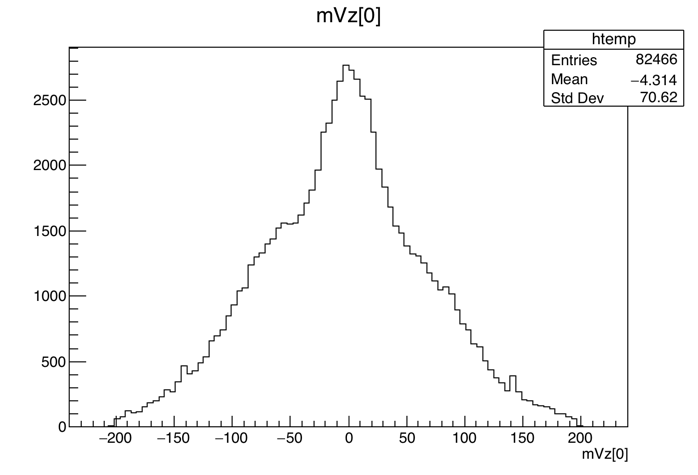
Vz from zdce_TOF0 is much broader than bbc_tac_TOF0. There seems to be 3 peaks merging together. (I somehow remember it is known issue, as in He3+Au data? but I forgot the explaination. Maybe related to bunching crosssing?)
TofMult<40 vs TofMult>=40
2.1 Vz
2.2 Number of primary tracks:
2.3 Vr vs Vz
Conclusion: zdce_TOF0 and bbc_tac_TOF0 doesn't have much difference in Ntrk (for both low and high TOFMult selections), but zdce_TOF0 has wider Vz with more peak structures (3 peaks maybe).
Check how does TOFMult work as central trigger. The concern is whether it is triggering on beam pipe interaction.
Dataset:
Run 16. d+Au@39GeV
Data are from one Run 17161027. It is the fastoffline prepared by James Daniel Brandenburg (jdb12@rice.edu). Thanks Daniel!
The events by following triggers bbc_tac_TOF0 and zdce_TOF0 are investigated (BBC_TOFMult was not adjusted at this early run).
As we proposed to set TOFMult=39 as the BBC_TOFMult new threshold. I will compare the events with TofMult>=40 vs TofMult<40.
bbc_tac_TOF0 and zdce_TOF0 are set up as MinBias triggers. Here we can also have some insight what is the difference between them. In order to compare these two MinBias triggers, the events with bbc_tac_TOF0 will be compared with events triggered by zdce_TOF0 but not by bbc_tac_TOF0.
Only default vertex is studied here.
Result:
1. bbc_tac_TOF0 events:
TofMult<40 vs TofMult>=40
1.1 Number of primary tracks with |eta|<1.2, |dca|<3
 |
 |
Note: TofMult>=40 has peak with higher number of primary tracks ~ 26. There is another smaller peak ~ 6. When we require TofMult > 65, this small peak at lower multiplicity (smaller mNtrk) will increase.
Here TofMult>=40 does have higher muliplicity.
Next question is whether it is beam pipe interaction. We will look at vertex distribution.
1.2 Primary Vertex Z
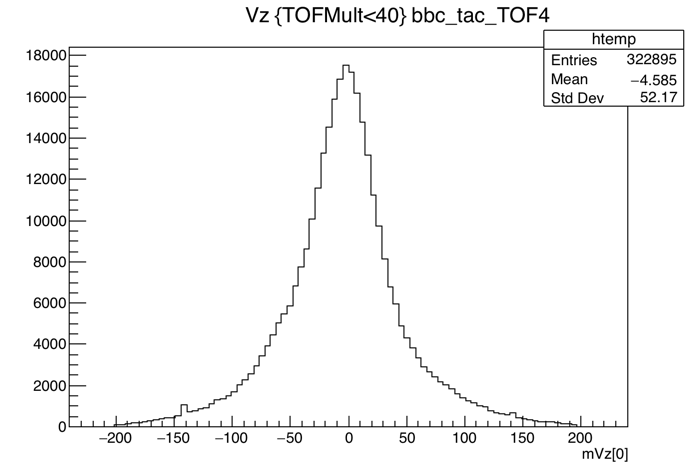 |
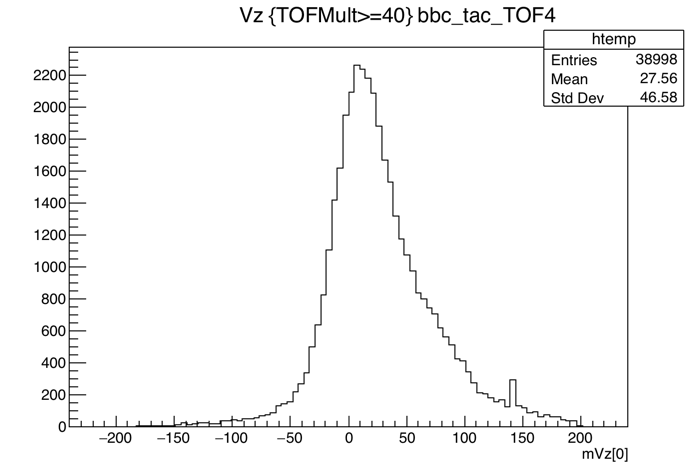 |
Note: For both cases, Vz is centered close to 0. However, TofMult>=40 one clearly has more events at positive Vz (d-going side). TofMult<40 is slightly more events at negative Vz.
1.3 Vr vs Vz
 |
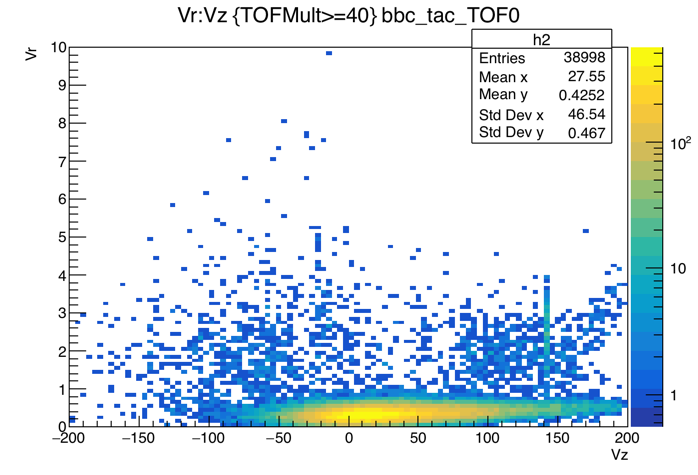 |
1.4 Vx vs Vy
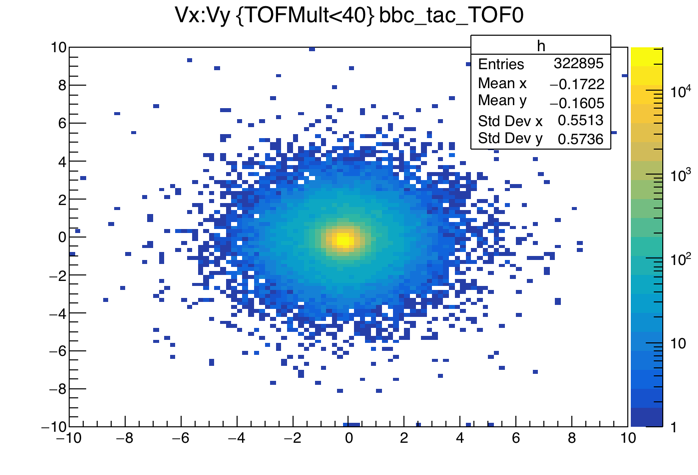 |
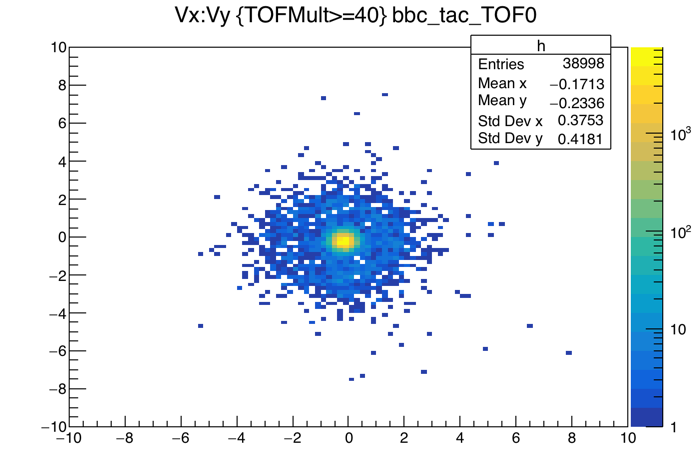 |
Note: High TofMult doesn't seem to be worse than low tofmult one. (High TofMult one does not have more beam pipe interaction than MB. )
1.5 Ntrk vs Vz
 |
 |
Then why high TOFmult is more weighted toward postive Vz?
If we combine the above two plot (without TofMult, just look at Ntrk vs Vz):

As Ntrk increases, Vz moves more towards positive side.
This is a d+Au collision! It is asymmetric, especially in central collisions.
PHOBOS measured d+Au@200GeV dN/deta distribution (although we are studying 39GeV, the idea is similar):

As we can see, the Au-going direction (negative eta) has more tracks. Here the collision vertex Z is centered at 0.
Now TOF acceptance is -0.9<eta<0.9 and BBC (tac for time difference in east and west) is not that efficient to catch events to be in the center 0. Then the peak of the dN/deta distribution will be catched by high TOF requirement. Image in the above plot, 0-20% peak at eta=-2 now moved to the region of -0.9<eta<0.9. Then collision vertex will be off center and moves to postivie eta, just as we observed.
Conclusion: I think it is reasonble that center trigger vertex z if off center and towards positive side. That is the feature of asymmetric d+Au collisions together with not that effective Vz position selection of BBC detector (the statement depends on how accurate is BBC vertex determination, which I don't know the precision).
However, if this is the case, the threshold we set could be triggering on collision with lower centrality than desired.
2. events triggered by zdce_TOF0, but not by bbc_tac_TOF0
Another MinBias trigger is zdce_TOF0.
First, Vz distribution with TofMult selection:

Vz from zdce_TOF0 is much broader than bbc_tac_TOF0. There seems to be 3 peaks merging together. (I somehow remember it is known issue, as in He3+Au data? but I forgot the explaination. Maybe related to bunching crosssing?)
TofMult<40 vs TofMult>=40
2.1 Vz
 |
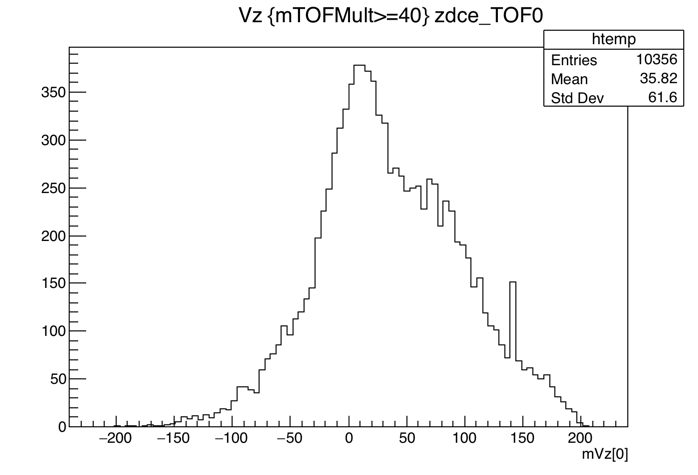 |
2.2 Number of primary tracks:
 |
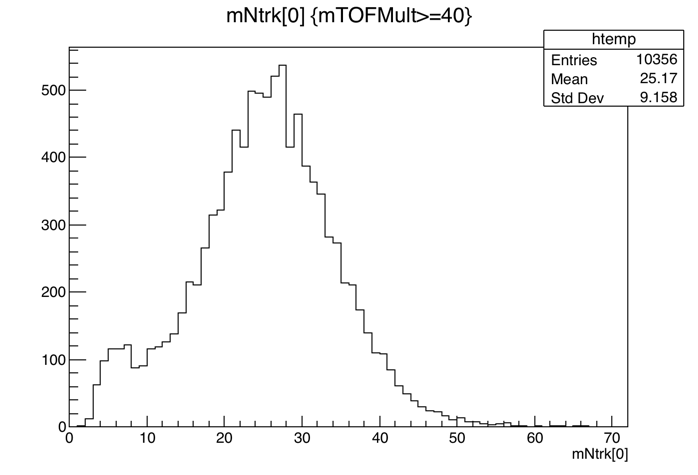 |
2.3 Vr vs Vz
 |
 |
Conclusion: zdce_TOF0 and bbc_tac_TOF0 doesn't have much difference in Ntrk (for both low and high TOFMult selections), but zdce_TOF0 has wider Vz with more peak structures (3 peaks maybe).
Groups:
- yili's blog
- Login or register to post comments
